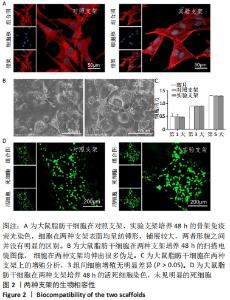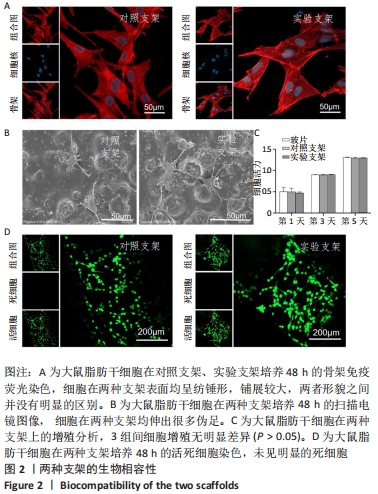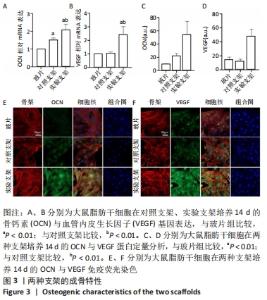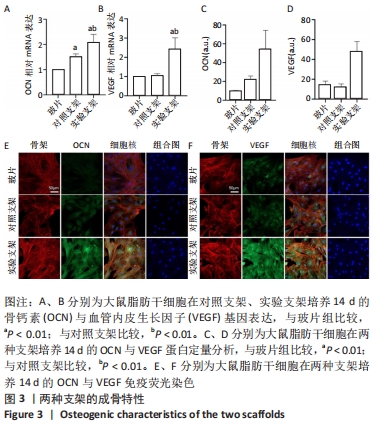Chinese Journal of Tissue Engineering Research ›› 2022, Vol. 26 ›› Issue (34): 5413-5418.doi: 10.12307/2022.448
Desferrioxamine-loaded polylactic-co-glycolic acid/hydroxyapatite composite scaffold: vascularization and osteogenesis
Zhang Shengmin1, Cao Changhong1, Wang Ningning1, Wang Jing1, Li Zhangyi2
- 1Department of Stomatology, Cangzhou Medical College, Cangzhou 061001, Hebei Province, China; 2Department of Stomatology, Tianjin Fifth Central Hospital, Tianjin 300450, China
-
Received:2021-03-11Accepted:2021-04-23Online:2022-12-08Published:2022-04-14 -
Contact:Li Zhangyi, Master, Associate chief physician, Department of Stomatology, Tianjin Fifth Central Hospital, Tianjin 300450, China -
About author:Zhang Shengmin, Master, Lecturer, Attending physician, Department of Stomatology, Cangzhou Medical College, Cangzhou 061001, Hebei Province, China -
Supported by:the Cangzhou Municipal Science and Technology Project, No. 183302068 (to ZSM); Cangzhou Medical College Doctoral Supervision Research Project, No. 19Z013 (to ZSM)
CLC Number:
Cite this article
Zhang Shengmin, Cao Changhong, Wang Ningning, Wang Jing, Li Zhangyi. Desferrioxamine-loaded polylactic-co-glycolic acid/hydroxyapatite composite scaffold: vascularization and osteogenesis[J]. Chinese Journal of Tissue Engineering Research, 2022, 26(34): 5413-5418.
share this article
Add to citation manager EndNote|Reference Manager|ProCite|BibTeX|RefWorks
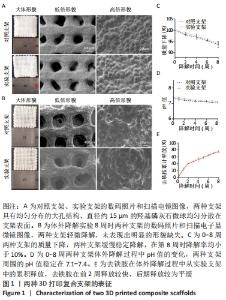
2.1 两种支架的表面形貌 扫描电子显微镜下可见两种支架具有均匀分布的大孔结构,经测量显示支架的孔径约510 μm,在高倍镜下支架表面略粗糙,可见直径约15 μm的羟基磷灰石微球均匀分散在支架表面,见图1A。数字化照片和扫描电镜显示,两种支架在表面形貌上并没有明显的差别,表明去铁胺的添加并不会改变支架表面形貌。 2.2 两种支架的体外降解性能 将两种支架在PBS中浸泡8周,发现支架形貌保持相对稳定,在第8周时支架未表现出形貌缺失,高倍放大扫描电镜显示支架孔径变大、边缘支撑结构变的窄小,表明支架出现了轻微的降解,见图1B,但并没有影响整体的形貌。两种支架缓慢稳定的出现质量丢失,在第8周时降解率均小于10%,见图1C,实验支架相比对照支架降解速率相对较慢,可能是由于去铁胺表面的羟基会与聚乳酸-羟基乙酸表面的羧基发生共价结合,这也表明去铁胺与支架材料具备稳定结合的能力;两种支架周围的pH值稳定在7.1-7.4,见图1D,与人体微环境的pH值相似,有利于维持周围细胞的活力和分化潜能,其中实验支架相比对照支架检测的pH值略高,这可能与实验支架降解速率较慢有关。 2.3 实验支架的体外缓释性能 将实验支架在PBS中浸泡8周发现,去铁胺在前2周释放较快,这有利于支架在植入前期迅速构建血管化成骨,后期去铁胺释放较为平缓,在8周内释放了75%左右,见图1E,这表明去铁胺后期释放速度较为稳定,这对支架植入后维持长期的血管化成骨有望发挥更好的作用。"
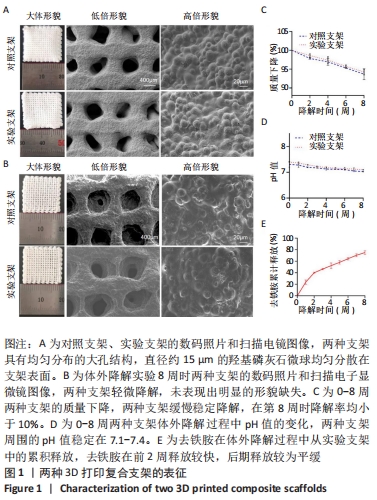
| [1] LIU WC, CHEN S, ZHENG L, et al. Angiogenesis Assays for the Evaluation of Angiogenic Properties of Orthopaedic Biomaterials - A General Review. Adv Healthc Mater. 2017;6(5):1600434. [2] SARAN U, GEMIBU PIPERNI S, CHATTERJEE S, et al. Role of angiogenesis in bone repair. Arch Biochem Biophys. 2014;1(561):109-117. [3] HAUSMAN MR, SCHAFFLER MB, MAJESKA RJ, et al. Prevention of fracture healing in rats by an inhibitor of angiogenesis. Bone. 2001; 29(6):560-564. [4] HUANG JH, LIN D, WEI ZY, et al. Parathyroid Homone Derivative with Reduced Osteoclastic Activity Promoted Bone Regeneration via Synergistic Bone Remodeling and Angiogenesis. Small. 2020;16(6): 1905876. [5] DANHIER F, ANSORENA E, SILVA JM, et al. PLGA-based nanoparticles: an overview of biomedical applications. J Control Release. 2012; 161(2): 505-522. [6] WENZ A, BORCHERS KIRSTEN, TOVAR GEM, et al. Bone matrix production in hydroxyapatite-modified hydrogels suitable for bone bioprinting. Biofabrication. 2017;9(4):044103. [7] BENDTSEN ST, QUINNELL SP, WEI M, et al. Development of a novel alginate-polyvinyl alcohol-hydroxyapatite hydrogel for 3D bioprinting bone tissue engineered scaffolds. J Biomed Mater Res A. 2017;105(5): 1457-1468. [8] YOU F, CHEN XB, COOPER DML, et al. Homogeneous hydroxyapatite/alginate composite hydrogel promotes calcified cartilage matrix deposition with potential for three-dimensional bioprinting. Biofabrication. 2018;11(1):015015. [9] JAKUS AE, SHAH RN. Multi and mixed 3D-printing of graphene-hydroxyapatite hybrid materials for complex tissue engineering. J Biomed Mater Res A. 2017;105(1):274-283. [10] SZCZES A, HOLYSZ L, CHIBOWSKI E. Synthesis of hydroxyapatite for biomedical applications. Adv Colloid Interfac. 2017;249:321-330. [11] SATTARY M, RAFIENIA M, KAZEMI M, et al. Promoting effect of nano hydroxyapatite and vitamin D3 on the osteogenic differentiation of human adipose-derived stem cells in polycaprolactone/gelatin scaffold for bone tissue engineering. Mat Sci Eng C-Mater. 2019;97:141-155. [12] GAO L, HUANG ZY, YAN SF, et al. Sr-HA-graft-Poly(gamma-benzyl-l-glutamate) Nanocomposite Microcarriers: Controllable Sr(2+) Release for Accelerating Osteogenenisis and Bony Nonunion Repair. Biomacromolecules. 2017;18(11):3742-3752. [13] MARX RE, SAWATARI Y, FORTIN M, et al. Bisphosphonate-induced exposed bone (osteonecrosis/osteopetrosis) of the jaws: risk factors, recognition, prevention, and treatment. J Oral Maxillofac Surg. 2005; 63(11):1567-1575. [14] MONDAL S, DOROZHKIN SV, PAL U, et al. Recent progress on fabrication and drug delivery applications of nanostructured hydroxyapatite. Wires Nanomed Nanobi. 2018;10(4):e1504. [15] GENTILE P, CHIONO V, CARMAGNOLA I, et al. An overview of poly(lactic-co-glycolic) acid (PLGA)-based biomaterials for bone tissue engineering. Int J Mol Sci. 2014;15(3):3640-3659. [16] XIE XH, WANG XL, ZHANG Z, et al. Structural and degradation characteristics of an innovative porous PLGA/TCP scaffold incorporated with bioactive molecular icaritin. Biomed Mater. 2010;5(5):054109. [17] QIN L, YAO D, ZHENG LZ, et al. Phytomolecule icaritin incorporated PLGA/TCP scaffold for steroid-associated osteonecrosis: Proof-of-concept for prevention of hip joint collapse in bipedal emus and mechanistic study in quadrupedal rabbits. Biomaterials. 2015;59:125-143. [18] WANG XL, XIE XH, ZHANG G, et al. Exogenous phytoestrogenic molecule icaritin incorporated into a porous scaffold for enhancing bone defect repair. J Orthop Res. 2013;31(1):164-172. [19] HOLDEN P, NAIR LS. Deferoxamine: An Angiogenic and Antioxidant Molecule for Tissue Regeneration. Tissue Eng Part B-Re. 2019;25(6): 461-470. [20] TCHANQUE-FOSSUO CN, DAHLE SE, BUCHMAN SR, et al. Deferoxamine: potential novel topical therapeutic for chronic wounds. Brit J Dermatol. 2017;176(4):1056-1059. [21] DUSCHER D, TROTSYUK AA, MAAN ZN, et al. Optimization of transdermal deferoxamine leads to enhanced efficacy in healing skin wounds. J Control Release. 2019;308:232-239. [22] QAYOOM A, ANEESHA VA, ANAGHA S, et al. Lecithin-based deferoxamine nanoparticles accelerated cutaneous wound healing in diabetic rats. Eur J Pharmacol. 2019;858:172478. [23] YAN YF, CHEN H, ZHANG HB, et al. Vascularized 3D printed scaffolds for promoting bone regeneration. Biomaterials. 2019;190-191:97-110. [24] LI HH, LUO BH, WEN W, et al. Deferoxamine immobilized poly(D,L-lactide) membrane via polydopamine adhesive coating: The influence on mouse embryo osteoblast precursor cells and human umbilical vein endothelial cells. Mat Sci Eng C-Mater. 2017;70:701-709. [25] RAN QC, YU YL, CHEN WZ, et al. Deferoxamine loaded titania nanotubes substrates regulate osteogenic and angiogenic differentiation of MSCs via activation of HIF-1alpha signaling. Mat Sci Eng C-Mater. 2018;91: 44-54. [26] JIA P, CHEN H, KANG H, et al. Deferoxamine released from poly(lactic-co-glycolic acid) promotes healing of osteoporotic bone defect via enhanced angiogenesis and osteogenesis. J Biomed Mater Res A. 2016; 104(10):2515-2527. [27] WEN Y, XUN S, HAOYE M, et al. 3D printed porous ceramic scaffolds for bone tissue engineering: a review. Biomater Sci-UK. 2017;5(9):1690-1698. [28] VENKATESAN J, BHATNAGAR I, MANIVASAGAN P, et al. Alginate composites for bone tissue engineering: A review. Int J Biol Macromol. 2015;72:269-281. [29] LECOMTE A, GAUTIER H, BOULER JM, et al. Biphasic calcium phosphate: a comparative study of interconnected porosity in two ceramics. J Biomed Mater Res B. 2008;84(1):1-6. [30] PEI X, MA L, ZHANG BQ, et al. Creating hierarchical porosity hydroxyapatite scaffolds with osteoinduction by three-dimensional printing and microwave sintering. Biofabrication. 2017;9(4):045008. [31] WANG XJ, LOU T, ZHAO WH, et al. The effect of fiber size and pore size on cell proliferation and infiltration in PLLA scaffolds on bone tissue engineering. J Biomater Appl. 2016;30(10):1545-1551. [32] LAI YX, CAO HJ, WANG XL, et al. Porous composite scaffold incorporating osteogenic phytomolecule icariin for promoting skeletal regeneration in challenging osteonecrotic bone in rabbits. Biomaterials. 2018;153:1-13. [33] CHEN SH, LEI M, XIE XH, et al. PLGA/TCP composite scaffold incorporating bioactive phytomolecule icaritin for enhancement of bone defect repair in rabbits. Acta Biomater. 2013;9(5):6711-6722. [34] XIE XH, WANG XL, ZHENG G, et al. Biofabrication of a PLGA-TCP-based porous bioactive bone substitute with sustained release of icaritin. J Tissue Eng Regen M. 2015;9(8):961-972. |
| [1] | Wang Jing, Xiong Shan, Cao Jin, Feng Linwei, Wang Xin. Role and mechanism of interleukin-3 in bone metabolism [J]. Chinese Journal of Tissue Engineering Research, 2022, 26(8): 1260-1265. |
| [2] | Tan Guozhong, Tu Xinran, Guo Liyang, Zhong Jialin, Zhang Yang, Jiang Qianzhou. Biosafety evaluation of three-dimensional printed gelatin/sodium alginate/58S bioactive glass scaffolds for bone defect repair [J]. Chinese Journal of Tissue Engineering Research, 2022, 26(4): 521-527. |
| [3] | Kang Kunlong, Wang Xintao. Research hotspot of biological scaffold materials promoting osteogenic differentiation of bone marrow mesenchymal stem cells [J]. Chinese Journal of Tissue Engineering Research, 2022, 26(4): 597-603. |
| [4] | Long Zhisheng, Xiong Long, Gong Feipeng, Li Jingtang, Zeng Jianhua, Deng Ying, Lan Min, Kong Weihao, Chen Gang. Effect of artificial bone with multi-scale hydroxyapatite/chitosan microtubule structure on rabbit bone defect repair and angiogenesis [J]. Chinese Journal of Tissue Engineering Research, 2022, 26(34): 5436-5441. |
| [5] | Cao Fei, Hui Min, Dong Xiling, Wang Le, Wang Zuxu, Zhang Min, Zhang Xiaoming, Liu Tongbin. Preparation of silver-loaded nanohydroxyapatite/polycaprolactone composite nanofiber scaffold and its osteogenic and antibacterial properties [J]. Chinese Journal of Tissue Engineering Research, 2022, 26(34): 5461-5467. |
| [6] | Wu Chengcong, Wang Fang, Wan Jianshan, Wu Zheng, Sun Rong, Huang Hefei, Qian Xuankun, Ou Hua, Ren Jing. Adenovirus-mediated bone morphogenetic protein 2 induces osteogenic differentiation of rabbit bone marrow mesenchymal stem cells [J]. Chinese Journal of Tissue Engineering Research, 2022, 26(30): 4757-4761. |
| [7] | Shen Enpu, Huang Ba, Liu Danping, Qi Hui, Wu Zhiwen, Li Beibei. Exosomes derived from melatonin-modified bone marrow mesenchymal stem cells promote osteogenesis of bone marrow mesenchymal stem cells [J]. Chinese Journal of Tissue Engineering Research, 2022, 26(30): 4800-4805. |
| [8] | Jia Qiyu, Huang Xiaoxia, Guo Jian, Huang Jinyong, Guo Xiaobin, Abdussalam·Alimujiang, Wu Tong, Ma Chuang. Integrin-targeted peptide promotes proliferation of bone marrow mesenchymal stem cells in SD rats [J]. Chinese Journal of Tissue Engineering Research, 2022, 26(30): 4780-4786. |
| [9] | Lu Yunan, Zhang Xinzhao, Lin Binbin, Xu Gan, Chen Jingdi, Chen Shunyou. Naringin-chitosan/hydroxyapatite composite scaffold in repair of rat skull defect [J]. Chinese Journal of Tissue Engineering Research, 2022, 26(28): 4441-4445. |
| [10] | Wu Yuchong, Peng Xu, Yu Xixun. Osteogenesis, angiogenesis and anti-aseptic loosening of europium-doped calcium polyphosphate bone tissue engineering scaffold [J]. Chinese Journal of Tissue Engineering Research, 2022, 26(28): 4458-4465. |
| [11] | Yun Xiao, Ding Tong, Yang Weiqiang, Guo Xinjun. Nano hydroxyapatite/chitosan scaffold loaded with Akebia saponin D in bone defect repair [J]. Chinese Journal of Tissue Engineering Research, 2022, 26(27): 4293-4299. |
| [12] | Liao Jun, Xu Pu. Effect of nanonized freshwater pearl powder on the expression of osteogenic related genes [J]. Chinese Journal of Tissue Engineering Research, 2022, 26(27): 4325-4329. |
| [13] | Zhao Doudou, Lin Kaili. Application of multicellular construction of vascularized tissue engineered bone in bone repair [J]. Chinese Journal of Tissue Engineering Research, 2022, 26(27): 4386-4392. |
| [14] | Xu Ran, Chen Xingyu, Li Zhiqiang. Antibacterial agents loaded on hydroxyapatite scaffolds: action mechanism between the drug and the scaffold [J]. Chinese Journal of Tissue Engineering Research, 2022, 26(27): 4411-4416. |
| [15] | Zhang Zihan, Wang Wenli, Li Jinnuo, Li Yourui. Carvacrol: antibacterial activity, bone repair, and prevention and treatment in oral diseases [J]. Chinese Journal of Tissue Engineering Research, 2022, 26(26): 4252-4257. |
| Viewed | ||||||
|
Full text |
|
|||||
|
Abstract |
|
|||||
